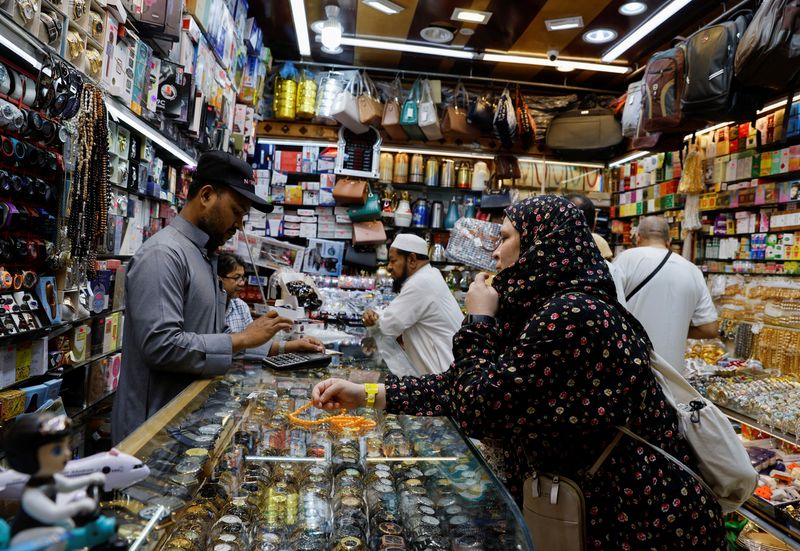By Rachna Uppal, Aziz El Yaakoubi and Yousef Saba
RIYADH (Reuters) -Saudi Arabia expects to post a second consecutive budget surplus in 2023, though down 84% from this year as an uncertain global economic outlook and lower crude prices look set to weigh on the top oil exporter’s revenues.
The kingdom approved a 1.114 trillion-riyal ($296 billion) budget for 2023 on Wednesday, forecasting a surplus at 0.4% of gross domestic product, down from an expected 2.6% in 2022.
Spending is slightly lower than 1.132 trillion riyals this year. Revenues are expected at 1.13 trillion riyals, down from 1.234 trillion riyals in 2022 as oil prices are seen falling from this year’s high levels.
“The economic impact (of moderate reduction in spending) is expected to be limited, especially with the PIF driving much of the investment activity,” said Monica Malik, chief economist at ADCB, referring to the Public Investment Fund, the country’s sovereign wealth fund.
Crown Prince Mohammed bin Salman, in remarks carried on state news agency SPA, said the budget surplus would be directed to boost government reserves, support state funds, like PIF, and strengthen the kingdom’s financial position.
Finance Minister Mohammed al-Jadaan told Saudi-owned Al Arabiya TV most of the surplus would likely go to boosting reserves, but a final decision has yet to be made.
High oil prices have helped Saudi Arabia’s fiscal balance to tilt to its first surplus since 2013 this year, expected at 102 billion riyals, an upwards revision from 2.3% of GDP expected in a pre-budget statement in September. It is however smaller than the 5.5% of GDP the IMF forecast in a report in August.
Al-Jadaan told reporters the adjustment in GDP for 2022 was “largely driven” by non-oil private sector activity, adding that output target cuts by the OPEC+ producers alliance in November and December had an impact on oil sector GDP.
“But that reduction was compensated by a better pick up in non-oil private sector activity,” al-Jadaan said. “And the likelihood is in the next three to five years we will have similar or higher growth in that sector.”
The kingdom does not disclose the oil price it bases its budget on. The International Monetary Fund (IMF) estimates the Saudi fiscal breakeven oil price at $73.3 a barrel this year and $66.8 next year.
ADCB’s Malik estimates the 2023 budget is based on an oil price of $78-80 and Mazen al-Sudairi, head of research at Al Rajhi Capital, estimates around $78.
FISCAL RESTRAINT
Saudi Arabia had pledged fiscal restraint after oil prices collapsed in the aftermath of the COVID-19 pandemic, though this year it boosted spending somewhat to cushion inflation for some of its citizens.
Al-Jadaan said the kingdom had made “very difficult decisions” after having in the last six to seven years depleted about 1 trillion riyals in government deposits and borrowed roughly the same amount to support budget deficits.
Among measures taken was tripling value-added tax to 15% in May 2020. When asked whether the kingdom plans to reduce the rate, al-Jadaan said: “Just having a surplus for one or two years and then rushing to change policies is premature.”
Economic growth is forecast to slow to 3.1% in 2023 from 8.5% this year, up half a percentage point from the pre-budget forecast. Public debt is seen falling 3.5% to 951 billion riyals next year, or 24.6% of GDP.
Government reserves at the Saudi Central Bank are estimated to reach 399 billion riyals at the end of next year, the finance ministry said.
With foreign direct investment – a key pillar of Prince Mohammed’s “Vision 2030” economic agenda – lagging for years, the PIF’s prominence has only grown.
Analysts say that given subdued investment by the local private sector and foreign investors, there is no substitute for the PIF’s enormous spending, which includes building NEOM, a $500 billion futuristic city in the desert.
The kingdom “is currently looking at the possibility of accelerating implementation of some strategic programmes and projects that are a priority,” Prince Mohammed said.
PIF, which doubled its assets to over $600 billion in about two years, has pledged to spend 3 trillion riyals in new sectors over the next 10 years, including $40 billion a year domestically through 2025.
The wealth fund and entities it owns or controls will continue to raise debt through banks and the public markets as their funding needs grow, analysts have said.
“We are going to continue to access debt markets, PIF will continue accessing international markets to manage theirs,” al-Jadaan said.
PIF last week raised a $17 billion loan to partly refinance an $11 billion loan it took in 2018. It also issued in October $3 billion in green bonds, a format the kingdom is also planning to tap.
($1 = 3.7600 riyals)
(Reporting by Aziz El Yaakoubi, Rachna Uppal in Riyadh, Alaa Swilam, Enas Alashray in Cairo, Nadine Awadalla and Yousef Saba in Dubai; Writing by Yousef Saba; Editing by Toby Chopra, William Maclean)
